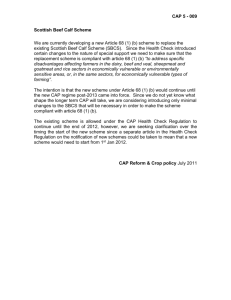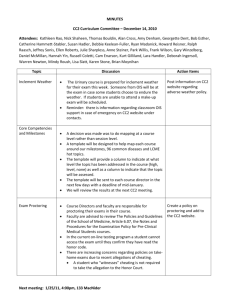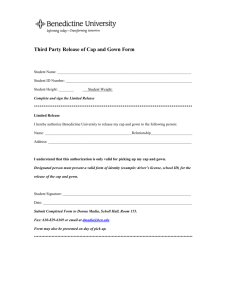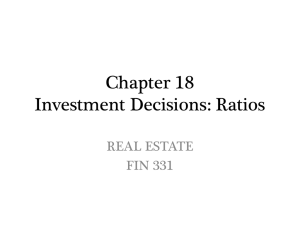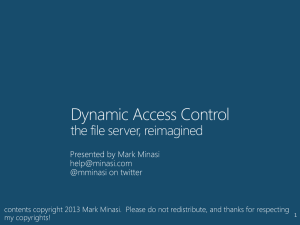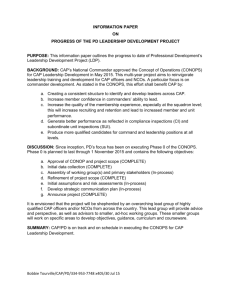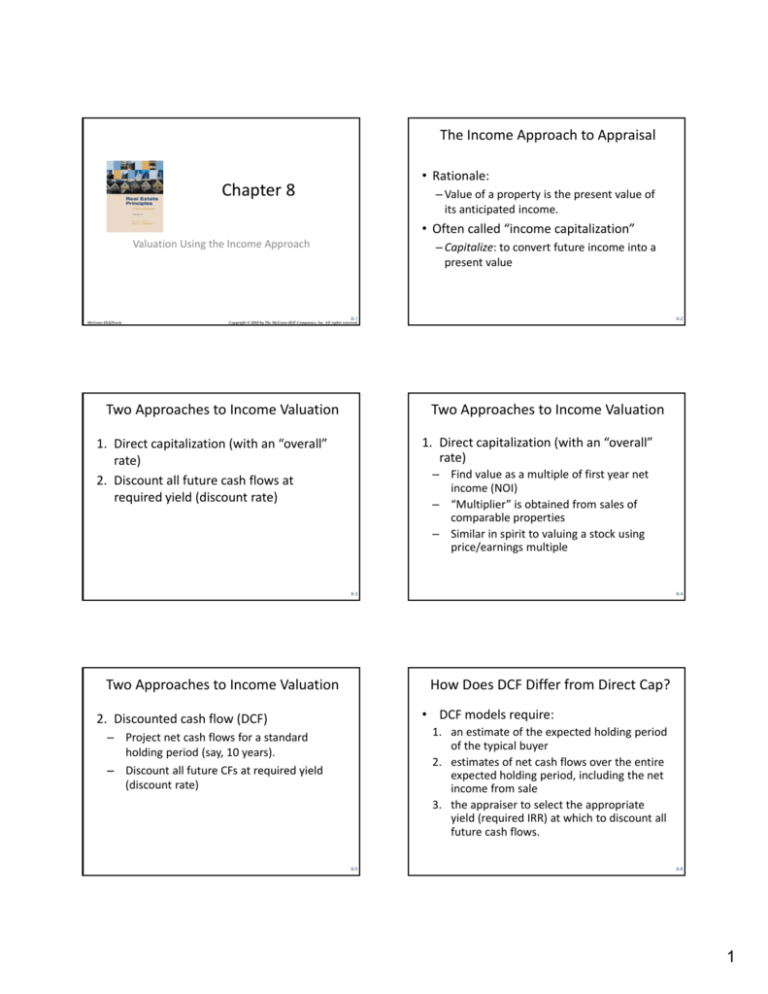
The Income Approach to Appraisal
• Rationale: Chapter 8
– Value of a property is the present value of its anticipated income.
• Often called “income capitalization”
Valuation Using the Income Approach
McGraw-Hill/Irwin
– Capitalize: to convert future income into a present value
8-1
8-2
Copyright © 2010 by The McGraw-Hill Companies, Inc. All rights reserved.
Two Approaches to Income Valuation
Two Approaches to Income Valuation
1. Direct capitalization (with an “overall” rate)
1. Direct capitalization (with an “overall” rate)
2. Discount all future cash flows at required yield (discount rate)
required yield (discount rate)
– Find value as a multiple of first year net income (NOI)
– “Multiplier” is obtained from sales of comparable properties
– Similar in spirit to valuing a stock using price/earnings multiple
8-3
Two Approaches to Income Valuation
8-4
How Does DCF Differ from Direct Cap?
• DCF models require:
2. Discounted cash flow (DCF)
1. an estimate of the expected holding period of the typical buyer
2. estimates of net cash flows over the entire expected holding period, including the net d h ldi
i d i l di
h
income from sale
3. the appraiser to select the appropriate yield (required IRR) at which to discount all future cash flows.
– Project net cash flows for a standard holding period (say, 10 years).
– Discount all future CFs at required yield Discount all future CFs at required yield
(discount rate)
8-5
8-6
1
Example: Centre Point Office Building
Estimating Net Operating Income
Sometimes referred to as a “reconstructed” operating statement
8-7
8-8
Potential Gross Income: Centre Point
Potential Gross Income (PGI)
First Floor
1,000 sq. ft. suites – 4 x $1,800 x 12 mos. = $86,400
• Potential gross income: Rental income assuming 100% occupancy
• Important issue: Contract rent or market rent?
Second Floor
800 sq. ft. suites – 2 x $1,800 x 12 mos. = $43,200
800
800 sq. ft. suites –
ft it
3 x $1,400 3 $1 400 x 12 mos. = $50,400 12
$50 400
= $93,600
Potential Gross Income = ($86,400 + $93,600)
= $180,000
8-9
Using Rent Comparables to Estimate Rental Rate (Exhibit 8‐3)
8-10
Types of Commercial Leases
• Straight lease: “Level” lease payments
• Step‐up or graduated lease: Rent increases on a predetermined schedule
• Indexed lease: Rent tied to an inflation index: Indexed lease: Rent tied to an inflation index:
Consumer Price Index, Union wage index, etc.
• Percentage lease: Rent includes percentage of tenant’s sales
Example: Survey of rental rates for second-floor offices in Centre Point:
Implications: 2nd floor rents average $1.95, consistent with mkt rates
8-11
8-12
2
Effective Gross Income
Effective Gross Income
• VC‐vacancy & collection loss is based on:
• Miscellaneous income
– Historical experience of subject property
– Competing properties in the market
– “Natural vacancy” rate: – Garage rentals & parking fees
– Laundry & vending machines
– Clubhouse rentals
• Vacancy
Vacancy rate that is expected in a stable or equilibrium rate that is expected in a stable or equilibrium
market
PGI
+
=
=
Potential Gross Income
PGI
VC Vacancy & Collection Loss
MI
Miscellaneous Income
EGI Effective Gross Income
OE Operating Expenses
CAPXCapital Expenditures
NOI Net Operating Income
+
=
=
8-13
Potential Gross Income
VC Vacancy & Collection Loss
MI
Miscellaneous Income
EGI Effective Gross Income
OE Operating Expenses
CAPXCapital Expenditures
NOI Net Operating Income
8-14
Operating Expenses
Centre Point Effective Gross Income
• Operating Expenses:
Potential gross income (PGI) $180,000
− Vacancy & collection loss (VC) 18,000 (@10%)
+ Miscellaneous income (MI)
( )
0
= Effective gross income (EGI) $162,000
– Ordinary & regular expenditures necessary to keep a property functioning competitively.
– Fixed: Expenses that do not vary with occupancy.
• insurance, su a ce,
• property taxes – Variable: Expenses that vary with occupancy.
• Utilities • Maintenance & supplies
• Trash and garbage removal
8-15
Operating Expenses
8-16
Capital Expenditures (CAPX)
• CAPX: Expenditures that materially increase value of structure or prolong its life:
• Do not include:
– Mortgage payments
– Tax depreciation
– Capital expenditures
PGI
+
=
=
– Roof replacement
– Additions
– HVAC Replacement
– Resurfacing of parking areas
– Tenant improvements
Potential Gross Income
VC Vacancy & Collection Loss
MI
Miscellaneous Income
EGI Effective Gross Income
OE Operating Expenses
CAPXCapital Expenditures
NOI Net Operating Income
8-17
8-18
3
Special Problem in Income Property Analysis: CAPX
Most appraisers treat CAPX as “above line” expense (see Exhibit 8‐4). Above Line
EGI
- OE
- CAPX
= NOI
Institutional
investors usually
treat CAPX as
“below line”
expense.
Below Line
EGI
- OE
= NOI
- CAPX
= Net Cash Flow
Reconstructed Operating Statement:
8-19
Some Sources of Industry Expense Data
8-20
Some Sources of Industry Expense Data
• Institute of Real Estate Management (IREM): www.irem.org
• International Council of Shopping Centers (ICSC): www.icsc.org
• Urban Land Institute (ULI): www.uli.org
• Local market participants
Local market participants
• Other pro formas you have seen
– Detailed information on apartments, offices, shopping centers, federally assisted housing and condominiums, co‐ops and planned communities.
• Building
Building Owners and Managers Association (BOMA): Owners and Managers Association (BOMA):
www.boma.org
– Large office buildings
8-21
8-22
First Income Valuation Method:
Direct Capitalization
Net Operating Income
• NOI is property's "dividend“
– Why is it not investor’s dividend?
• Projected stream of NOI is fundamental determinant of value
• NOI must be sufficient to
Basic value equation:
– service the mtg debt and
g
– provide equity investor with an acceptable return on equity
PGI Potential Gross Income
• Be careful of NOI vs. NCF
- VC Vacancy & Collection Loss
+
=
=
V
NOI1
Ro
Warning!!!!!!!
Ro is a “cap” rate
Ro is NOT a discount rate!!!!
MI
Miscellaneous Income
EGI Effective Gross Income
OE Operating Expenses
CAPXCapital Expenditures
NOI Net Operating Income
8-23
8-24
4
Direct Capitalization for Centre Point Case
Steps in Direct Capitalization
Step 1: Extract Ro from the market.
1. Obtain estimates of cap rates, Ro,, from the
market using the “direct market extraction”
equation:
Ro
NOI1
Selling Pr ice
From a comparable p
property
2. Divide the subject’s NOI1 by a weighted
average of the abstracted Ros to obtain an
estimate of value for the subject
Note: We have assumed each is equally comparable to subject
From where do you obtain comparable NOIs and sales prices?
8-25
Other Sources of Cap Rates
Direct Capitalization for Centre Point Case
• Real Estate Research Corporation’s Real Estate Report: www.rerc.com
• RealtyRates.com: www.realtyrates.com
• Grubb & Ellis: www.grubb‐ellis.com
• Legg‐Mason Real Estate Services: www.lmres.com
• CoStar (www.costar.com)
• Other appraisers & market participants
2. Compute estimated market value, using first year
NOI:
Value
8-26
$89,100
$900,000
0.099
Value $89,100 x 10.1 $900,000
8-27
Important Points About Cap Rates
8-28
Important Points About Cap Rates
• Direct capitalization only uses first year NOI, but Ro reflects all future cash flows:
• Ro: Overall rate of capitalization, or “going‐in” cap rate.
• Ro: A ratio of initial cash flow to value
–Transaction prices of the comparables Transaction prices of the comparables
reflect the value of future cash flows.
–In turn, the cap rates extracted from these purchases do so as well.
– Future cash flows and changes in asset value also are important • Not a yield/discount rate.
8-29
8-30
5
Effect of Appreciation on Cap Rate: Example of Centre Point
Understanding Cap Rates
• Assume the following first‐year cash flows for Centre Point:
• Suppose required one‐year IRR is 11.75%
• Suppose income growth results in a sale price at end of year 1 of $930,000. What is the resulting cap rate?
• Total year 1 cash flows:
$89,100 + 930,000 = $1,019,100
• PV @ 11.75% discount = $911,946
• Resulting cap rate = 89,100 ÷ 911,946 = 9.77%
Conclusion: With required yield constant, more appreciation implies lower cap rate
– Purchase price: $900,000
– NOI: $89,100
– Sale Price at the end of year 1: $916,650
– Costs of sale: $0.00
89,100 16,650
Going inIRR
11.75%
900,000
89,100
16,650
900,000 900,000
0.099 0.0185
= cap rate + appreciation rate
8-31
Effective Gross Rent Multiplier Example
Effective Gross Income Multiplier
• EGIM = Sale price ÷ Effective gross income
• Quick indicator of value for smaller rental properties
• Requires no operating expense information q
p
g p
• Critical assumptions
– Roughly equal operating expense percentages across properties
– Assumes market rents are paid
• Best used for properties with short‐term leases (apartments & rental houses)
8-32
Indicated value = 5.53 x EGI
of subject
= 5.53 x 162,000
= 895,860, or $896,000
8-33
Problems with Valuation by Direct Capitalization
8-34
DCF Example: Centre Point
• Inadequate data on comparable sales due to:
– Above‐ or below‐market leases
– Differing length of leases and rent escalations
– Differing distributions of operating expenses Differing distributions of operating expenses
between landlord and tenant
Sale price at end of Year 5 = NOI6 ÷ Rt = $103,291/0.100
= $1,033,000
Where Rt is a terminal or “going-out” cap rate, slightly
higher than Ro
Sale price (SP)
$1,033,000
−Selling expenses (SE)
58,300
= Net sale proceeds (NSP)
$ 974,700
• Differing prices between institutional and private investors for similar properties
• Result: Discounted cash flow (DCF) analysis can be preferable
8-35
8-36
6
Valuation of the Unlevered Cash Flows:
Centre Point Reconciliation of Value Indicators
Discount rate presumed to reflect required yield in market for unlevered
investments of similar risk
For surveys of unlevered yields, see RERC www.rerc.com
8-37
8-38
Work of Appraiser Requires Analytical AND People Skills
So…What’s Better? • Is direct capitalization using Ro superior to valuation by DCF?
Develop
network
of data
contacts
– Fewer explicit assumptions and forecasts are required
– What implicit assumption are you making?
Be skilled in
data analysis
and report
production
Collect, read,
interpret, and
organize data
and reports
Fight time
deadlines
8-39
8-40
Alternate Methods of Estimating Cap Rates: Mortgage‐Equity Rate • Problem: Cannot estimate cap rates without actual sales
• Solution 1: Since income‐producing real q y
g,
estate has both equity and debt financing, think of the cap rate as a weighted average of equity cap rate and mortgage cap rate • Equity cash flow = NOI – Debt service
= Before tax cash flow
= BTCF
• Loan cash flow = Monthly payment x 12 Appendix: Other Methods of Estimating Cap Rates 8-41
8-42
7
Mortgage‐Equity Cap Rate: Example
Mortgage‐Equity Rate (continued)
• Equity • Equity cap rate • Loan cap rate • Loan‐to‐value ratio = Purchase price – Loan
= BTCF ÷ Equity = Re (equity dividend rate)
= Loan cash flow ÷ loan
= Rm (Loan constant)
= R
(Loan constant)
= Loan amount ÷ Price
= m (Mortgage‐equity cap rate)
= m x Rm + (1−m) x Re
•
•
•
•
Equity dividend rate (from market) = 11.5%
Typical mortgage loan cap rate = 8.89%
Typical loan‐to‐value ratio = 70%
Mortgage‐equity cap rate:
R = .70 x 8.89 + (1 − .70) x 11.5
= 0.967, or 9.67%
8-43
8-44
Selecting Among Different Cap Rate Estimates
Constant Growth Cap Rate
• Recall one‐year total yield example:
• Direct extraction is preferred, but needs three or more comparables with good information
• Choice ultimately depends on quality of data available for each type of estimate
• Reconciliation made by weighting
Total yield = Cap rate + Appreciation rate
=> Cap rate = Total yield – Appreciation rate
• A
Assume required total yield is 11.75%
i d
l i ld i 11 75%
• Assume expected appreciation rate of 2.0%
=> cap rate = 11.75 – 2.0 = 9.75%
8-45
8-46
End of Chapter 8
8-47
8

